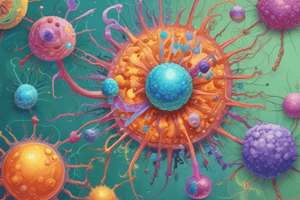Podcast
Questions and Answers
What is the primary outcome for immature lymphocytes that encounter self antigens in central tolerance?
What is the primary outcome for immature lymphocytes that encounter self antigens in central tolerance?
- They proliferate uncontrollably.
- They undergo anergy.
- They remain unaffected by the encounter.
- They are deleted or change their specificity. (correct)
Which mechanism is NOT part of peripheral T cell tolerance?
Which mechanism is NOT part of peripheral T cell tolerance?
- Anergy
- Suppression by Tregs
- Positive selection (correct)
- Deletion
What role does the autoimmune regulator (AIRE) protein play in T cell tolerance?
What role does the autoimmune regulator (AIRE) protein play in T cell tolerance?
- It induces T cell activation.
- It prevents the deletion of self-reactive T cells.
- It helps express peripheral tissue antigens in medullary thymic epithelial cells. (correct)
- It enhances the production of all antigens in the thymus.
How do CD4+ T cells develop into regulatory T cells (Tregs) during central tolerance?
How do CD4+ T cells develop into regulatory T cells (Tregs) during central tolerance?
What is anergy in the context of peripheral T cell tolerance?
What is anergy in the context of peripheral T cell tolerance?
Which of the following best describes central tolerance?
Which of the following best describes central tolerance?
Which of the following mechanisms contributes to T cell tolerance towards tissue-specific self antigens not abundant in the thymus?
Which of the following mechanisms contributes to T cell tolerance towards tissue-specific self antigens not abundant in the thymus?
What is the outcome for T cells that do not undergo negative selection in the thymus?
What is the outcome for T cells that do not undergo negative selection in the thymus?
What is the primary role of Interleukin-10 (IL-10) in immune regulation?
What is the primary role of Interleukin-10 (IL-10) in immune regulation?
Which statement accurately describes tolerogenic antigens?
Which statement accurately describes tolerogenic antigens?
What occurs to immature B lymphocytes that recognize self antigens with high affinity in the bone marrow?
What occurs to immature B lymphocytes that recognize self antigens with high affinity in the bone marrow?
What is a consequence of failure of self-tolerance in the immune system?
What is a consequence of failure of self-tolerance in the immune system?
What defines central tolerance in B cells?
What defines central tolerance in B cells?
Which factor is crucial in determining the immune response to T lymphocytes?
Which factor is crucial in determining the immune response to T lymphocytes?
What happens to mature B lymphocytes that recognize self antigens in peripheral tissues in the absence of specific helper T cells?
What happens to mature B lymphocytes that recognize self antigens in peripheral tissues in the absence of specific helper T cells?
What is the outcome when immature T cells encounter self antigens in the thymus?
What is the outcome when immature T cells encounter self antigens in the thymus?
What is a primary mechanism that contributes to T cell anergy?
What is a primary mechanism that contributes to T cell anergy?
How does CTLA-4 prevent T cell activation?
How does CTLA-4 prevent T cell activation?
What role does interleukin-2 (IL-2) play in the function of regulatory T cells (Tregs)?
What role does interleukin-2 (IL-2) play in the function of regulatory T cells (Tregs)?
What inhibitory cytokine is primarily produced by CD4+ Tregs?
What inhibitory cytokine is primarily produced by CD4+ Tregs?
Which of the following statements about CTLA-4 is true?
Which of the following statements about CTLA-4 is true?
How does TGF-β1 influence T cell differentiation?
How does TGF-β1 influence T cell differentiation?
What occurs when T cells recognize self antigens without costimulation?
What occurs when T cells recognize self antigens without costimulation?
What is a significant effect of TGF-β1 on macrophages?
What is a significant effect of TGF-β1 on macrophages?
What is the result when immature B cells recognize multivalent self antigens in the bone marrow?
What is the result when immature B cells recognize multivalent self antigens in the bone marrow?
Which factor is NOT typically associated with the development of autoimmunity?
Which factor is NOT typically associated with the development of autoimmunity?
What is defined as defective self-tolerance in the context of autoimmunity?
What is defined as defective self-tolerance in the context of autoimmunity?
What ultimately happens to mature B cells that recognize self antigens in the absence of T cell help?
What ultimately happens to mature B cells that recognize self antigens in the absence of T cell help?
What contributes to tissue injury in autoimmune diseases?
What contributes to tissue injury in autoimmune diseases?
Which statement accurately describes one of the causes of autoimmune diseases?
Which statement accurately describes one of the causes of autoimmune diseases?
Which of the following is an indication of defective apoptosis in autoimmune diseases?
Which of the following is an indication of defective apoptosis in autoimmune diseases?
What may contribute to the abnormal display of self antigens in autoimmune conditions?
What may contribute to the abnormal display of self antigens in autoimmune conditions?
Flashcards are hidden until you start studying
Study Notes
Central Tolerance
- Immature lymphocytes specific for self-antigens encounter these antigens in the generative lymphoid organs and undergo deletion, change their specificity (B cells only), or become regulatory lymphocytes (Tregs).
Peripheral tolerance
- Self-reactive lymphocytes mature and enter peripheral tissues and may be inactivated or deleted by an encounter with self antigens or are suppressed by Tregs.
Central T Cell Tolerance
- Immature T cells recognizing antigens with high avidity die; some surviving CD4+ cells become Tregs.
- Death of immature T cells due to antigen recognition in the thymus is called deletion or negative selection.
AIRE in Deletion of T Cells
- The thymus expresses various circulating and cell-associated proteins widely distributed in tissues.
- The thymus expresses numerous protein antigens not ubiquitously expressed but limited to peripheral tissues.
- These peripheral tissue antigens are produced in MTECs under the control of the AIRE protein.
Mechanisms of Peripheral T Cell Tolerance
- Peripheral tolerance mechanisms include anergy (functional unresponsiveness), suppression by Tregs, and deletion.
- These mechanisms may be responsible for T cell tolerance to tissue-specific self antigens, especially those not abundant in the thymus.
- These mechanisms may also induce unresponsiveness to foreign antigens under tolerogenic conditions.
Mechanisms of T Cell Anergy
- TCR-induced signal transduction is blocked in anergic cells.
- Self antigen recognition without costimulation may activate cellular ubiquitin ligases, targeting TCR-associated proteins for degradation.
- When T cells recognize self antigens without innate immune responses, they engage inhibitory receptors of the CD28 family to terminate T cell responses.
CTLA-4 Mechanisms of Action
- CTLA-4 acts as a competitive inhibitor of CD28, reducing B7 availability for the CD28 receptor.
- CTLA-4 is expressed constitutively on Tregs and transiently on activated T cells, preventing activation of responding T cells.
- CTLA-4 on one T cell (a Treg) can inhibit responses of other T cells.
CTLA-4 and PD-1 Actions and Functions
- CTLA-4 and PD-1 are receptors expressed on T cells and other immune cells that play inhibitory roles in immune regulation.
Regulatory T Cells
- Tregs are a specialized subset of T lymphocytes that play a critical role in suppressing immune responses to self antigens, preventing autoimmune diseases.
IL-2 in Maintenance of Tregs
- Tregs suppress immune responses through multiple steps including:
- Production of immunosuppressive cytokines IL-10 and TGF-β.
- Reduced ability of APCs to stimulate T cells.
- Consumption of IL-2.
Inhibitory Cytokines Produced by Regulatory T Cells
- Transforming Growth Factor-β (TGF-β1) is produced by Tregs and inhibits the proliferation and effector functions of T cells and the activation of macrophages.
- Interleukin-10 (IL-10) is an inhibitor of activated macrophages and dendritic cells, involved in controlling innate immune reactions and cell-mediated immunity.
Pathways of Apoptosis
- When T cells avidly recognize self antigens, they undergo apoptosis.
- Repeated stimulation of T cells can also lead to apoptosis.
Factors Determining Immunogenicity and Tolerogenicity
- Tolerogenic antigens are expressed in generative lymphoid organs, recognized by immature lymphocytes.
- In peripheral tissues, self antigens engage antigen receptors of specific lymphocytes for prolonged periods without inflammation or innate immunity.
- The nature of the dendritic cell displaying antigens to T lymphocytes is vital for determining the subsequent response.
Central Tolerance in B Cells
- Immature B lymphocytes recognizing self antigens in the bone marrow with high affinity change their specificity or are deleted.
- Mature B lymphocytes recognizing self antigens in peripheral tissues without specific helper T cells may become unresponsive or undergo apoptosis.
Summary
- Immunologic tolerance is unresponsiveness to an antigen induced by exposure of specific lymphocytes to that antigen.
- Tolerance to self antigens is essential for a normal immune system; failure leads to autoimmune diseases.
- Central tolerance is induced in the generative lymphoid organs (thymus and bone marrow) when immature lymphocytes encounter self antigens.
- Peripheral tolerance occurs when mature lymphocytes recognize self antigens in peripheral tissues.
- Some immature T cells encountering self antigens in the thymus die (negative selection), and others develop into FoxP3+ regulatory T lymphocytes (Tregs).
- Anergy is induced by antigen recognition without adequate costimulation or by engagement of inhibitory receptors like CTLA-4 and PD-1.
- In B lymphocytes, central tolerance is induced when immature B cells recognize multivalent self antigens in the bone marrow, resulting in receptor editing or apoptotic death.
- Mature B cells recognizing self antigens in the periphery without T cell help may become anergic or unresponsive due to inhibitory receptor engagement.
Postulated Mechanisms of Autoimmunity
- Autoimmunity arises from genetic susceptibility and environmental triggers like infections and tissue injury.
- Autoimmune diseases can be systemic or organ-specific, depending on the autoantigens targeted.
- Various effector mechanisms cause tissue damage in autoimmune diseases (immune complexes, circulating autoantibodies, autoreactive T lymphocytes).
- Autoimmune diseases are chronic, progressive, and self-perpetuating.
Immunologic Abnormalities Leading to Autoimmunity
- Defective self-tolerance: Imbalance between lymphocyte activation and control underlies all autoimmune diseases.
- Defects in deletion (negative selection) of T or B cells or receptor editing in B cells during maturation.
- Insufficient numbers or functions of regulatory T lymphocytes.
- Defective apoptosis of mature self-reactive lymphocytes.
- Impaired function of inhibitory receptors.
- Abnormal display of self antigens: increased expression and persistence of self antigens or structural changes leading to neoantigens.
Studying That Suits You
Use AI to generate personalized quizzes and flashcards to suit your learning preferences.




